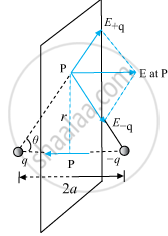Advertisements
Advertisements
प्रश्न
Answer the following question.
Derive an expression for the electric field at any point on the equatorial line of an electric dipole.
उत्तर
Electric field for points on the equator plane

The magnitude of the electric field due to two charges +q and –q is
`E_(+q) = q/(4piε_0)1/(r^2 + a^2)`
`E_(-q) = q/(4piε_0)1/(r^2 + a^2)`
`E_(+q) = E_(-q)`
The directions of `E_(+q) and E_(-q)`, are as shown in the figure. The components normal to the dipole axis cancel away. The components along the dipole axis add up.
Total electric field, `E = -(E_(+q) + E_(-q)) costheta hatp` ......(Negative sign shows that the field is opposite to `hatp`)
`E = -(2qa)/(4piε_0(r^2 + a^2)^(3/2))hatp` ...(iii)
At large distance (r >> a), this reduces to,
`E = -(2qa)/(4piε_0r^3)hatp`
`vecp = q xx 2vecahatp`
`E = -vecp/(4piε_0r^3)` ....(r >> a)
संबंधित प्रश्न
Drive the expression for electric field at a point on the equatorial line of an electric dipole.
(i)Obtain the expression for the torque `vecτ` experienced by an electric dipole of dipole moment `vecP` in a uniform electric field, `vecE` .
(ii) What will happen if the field were not uniform?
(a) Define torque acting on a dipole of dipole moment \[\vec{p}\] placed in a uniform electric field \[\vec{E}\] Express it in the vector from and point out the direction along which it acts.
(c) What would happen if the external field
An electric dipole is placed at an angle of 30° with an electric field intensity of 2 × 105 N/C. It experiences a torque equal to 4 Nm. The charge on the dipole, if the dipole length is 2 cm, is ______.
An electric dipole of moment p is placed parallel to the uniform electric field. The amount of work done in rotating the dipole by 90° is ____________.
The electric intensity due to a dipole of length 10 cm and having a charge of 500 µC, at a point on the axis at a distance 20 cm from one of the charges in air, is:
Electric dipole consists of two charges of magnitude 0.1 µC separated by a distance of 2 cm. The dipole is in 5 an external field of 105 N/C. What maximum torque does the field exert on the dipole?
Polar molecules are the molecules ______.
